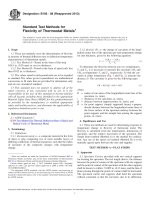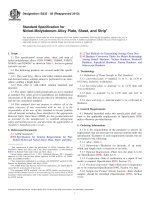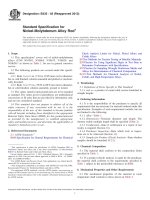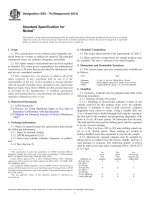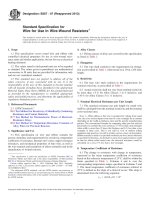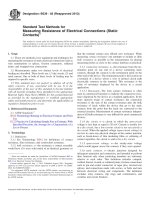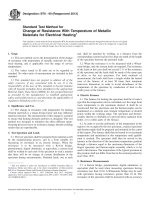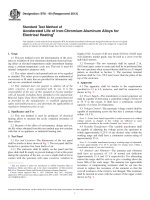Astm b 428 09 (2013)
Bạn đang xem bản rút gọn của tài liệu. Xem và tải ngay bản đầy đủ của tài liệu tại đây (170.38 KB, 3 trang )
Designation: B428 − 09 (Reapproved 2013)
Standard Test Method for
Angle of Twist in Rectangular and Square Copper and
Copper Alloy Tube1
This standard is issued under the fixed designation B428; the number immediately following the designation indicates the year of
original adoption or, in the case of revision, the year of last revision. A number in parentheses indicates the year of last reapproval. A
superscript epsilon (´) indicates an editorial change since the last revision or reapproval.
This standard has been approved for use by agencies of the U.S. Department of Defense.
1. Scope
4.2 This test method provides a procedure for measuring the
twist in square and rectangular copper and copper alloy tubes
as a measure of the deviation from straightness.
1.1 This test method establishes the requirements for the
determination of the angle of twist in rectangular and square
copper and copper alloy tube.
4.3 This test method allows the purchaser and supplier or
manufacturer to inspect square and rectangular copper and
copper alloy tube with a standard technique that provides
acceptable twist in delivered tubes.
1.2 The values stated in inch-pound units are to be regarded
as standard. No other units of measurement are included in this
standard.
1.3 This standard does not purport to address all of the
safety concerns, if any, associated with its use. It is the
responsibility of the user of this standard to establish appropriate safety and health practices and determine the applicability of regulatory limitations prior to use.
5. Apparatus
5.1 Horizontal Reference Plane (see Fig. 1 (a) and (b)) of
sufficient length to support the tube specimen and a clamping
device to hold one end of the specimen against the reference
plane.
5.2 Transparent Plastic Protractor Segment engraved with
angle lines as shown in Fig. 1 (c).
2. Referenced Documents
2
2.1 ASTM Standards:
B846 Terminology for Copper and Copper Alloys
5.3 Parallel Face Blocks.
3. Terminology
6. Test Specimen
3.1 For definitions of terms related to copper and copper
alloys, refer to Terminology B846.
6.1 The test specimen shall be cut to a minimum length of
10 in. and a maximum length of 15 in.
4. Significance and Use
7. Procedure
4.1 The rectangular or square copper alloy tube covered by
this test method may be used in applications in which control
of twist is important to proper fit in final assembly and to
minimize rework to bring the tube into compliance. It is
recognized that the amount of twist, in degrees, per increment
of length can change as a result of the weight of the product
and its length during measurement.
7.1 Place the tube specimen lengthwise on the reference
plane. Whenever the specimen has noticeable edgewise
curvature, place the specimen so that a side having convex
curvature is in contact with the reference plane. Further
placement requirements are as follows:
7.1.1 For rectangular tube, place a major outer dimension
side (width side) against the reference plane, as shown in Fig.
1 (a).
7.1.2 For square tube, having curvature along all edges,
place the specimen so that the side with the least convex
curvature is against the reference plane.
1
This test method is under the jurisdiction of ASTM Committee B05 on Copper
and Copper Alloys and is the direct responsibility of Subcommittee B05.06 on
Methods of Test.
Current edition approved Oct. 1, 2013. Published November 2013. Originally
approved in 1965. Last previous edition approved in 2009 as B428 – 09. DOI:
10.1520/B0428-09R13.
2
For referenced ASTM standards, visit the ASTM website, www.astm.org, or
contact ASTM Customer Service at For Annual Book of ASTM
Standards volume information, refer to the standard’s Document Summary page on
the ASTM website.
7.2 Clamp one end of the specimen so that the tube surface,
adjacent to that end and facing the reference plane, will be in
firm contact with this plane. Keep the other end of the
specimen free.
7.3 Position the protractor segment flush against the free
end of the specimen, as shown in Fig. 1 (b), and measure the
Copyright © ASTM International, 100 Barr Harbor Drive, PO Box C700, West Conshohocken, PA 19428-2959. United States
1
B428 − 09 (2013)
FIG. 1 Horizontal Reference Plane (a), (b) and Transparent Plastic Protractor Segment (c)
total angle of twist by reading the degrees for that angle line
which most nearly coincide with the lower outside edge of the
tube end. In making this reading, keep the lower edge of the
protractor segment in contact with the reference plane or hold
it parallel to this plane by use of the parallel face blocks.
8.2 This test method has no bias because the values of twist
are a direct measurement based on the accuracy of the
protractor and the observation of the operator.
7.4 The angle of twist per unit length is the total angle of
twist for the specimen divided by its length and shall be
calculated according to the units required by the product
specification.
9.1 angle of twist; copper; copper alloy; rectangular tube;
square tube; twist
9. Keywords
8. Precision and Bias
8.1 This test method is unaffected by edgewise curvature of
the specimen, and the precision for measurement of total angle
of twist is 60.5°.
2
B428 − 09 (2013)
ASTM International takes no position respecting the validity of any patent rights asserted in connection with any item mentioned
in this standard. Users of this standard are expressly advised that determination of the validity of any such patent rights, and the risk
of infringement of such rights, are entirely their own responsibility.
This standard is subject to revision at any time by the responsible technical committee and must be reviewed every five years and
if not revised, either reapproved or withdrawn. Your comments are invited either for revision of this standard or for additional standards
and should be addressed to ASTM International Headquarters. Your comments will receive careful consideration at a meeting of the
responsible technical committee, which you may attend. If you feel that your comments have not received a fair hearing you should
make your views known to the ASTM Committee on Standards, at the address shown below.
This standard is copyrighted by ASTM International, 100 Barr Harbor Drive, PO Box C700, West Conshohocken, PA 19428-2959,
United States. Individual reprints (single or multiple copies) of this standard may be obtained by contacting ASTM at the above
address or at 610-832-9585 (phone), 610-832-9555 (fax), or (e-mail); or through the ASTM website
(www.astm.org). Permission rights to photocopy the standard may also be secured from the Copyright Clearance Center, 222
Rosewood Drive, Danvers, MA 01923, Tel: (978) 646-2600; />
3
